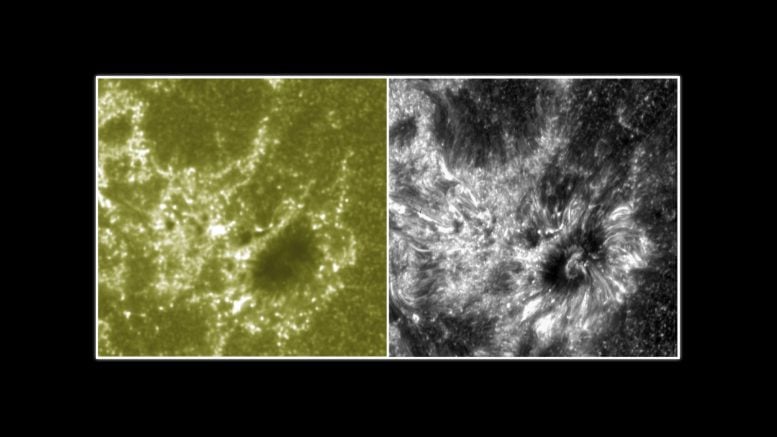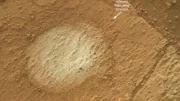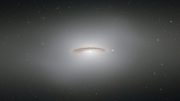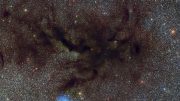
These two images show a section of the sun as seen by NASA’s Interface Region Imaging Spectrograph, or IRIS, on the right and NASA’s SDO on the left. The IRIS image provides scientists with unprecedented detail of the lowest parts of the sun’s atmosphere, known as the interface region. Credit: NASA/SDO/IRIS
NASA’s Interface Region Imaging Spectrograph (IRIS) took its first images of the Sun, revealing the mysterious lowest layers of the sun’s atmosphere.
The moment when a telescope first opens its doors represents the culmination of years of work and planning — while simultaneously laying the groundwork for a wealth of research and answers yet to come. It is a moment of excitement and perhaps even a little uncertainty. On July 17, 2013, the international team of scientists and engineers who supported and built NASA’s Interface Region Imaging Spectrograph, or IRIS, all lived through that moment. As the spacecraft orbited around Earth, the door of the telescope opened to view the mysterious lowest layers of the sun’s atmosphere and the results thus far are nothing short of amazing. The data is crisp and clear, showing unprecedented detail of this little-observed region.
“These beautiful images from IRIS are going to help us understand how the sun’s lower atmosphere might power a host of events around the sun,” said Adrian Daw, the mission scientist for IRIS at NASA’s Goddard Space Flight Center in Greenbelt, Maryland. “Anytime you look at something in more detail than has ever been seen before, it opens up new doors to understanding. There’s always that potential element of surprise.”
As the telescope door opened on July 17, 2013, IRIS’s single instrument began to observe the sun in exceptional detail. IRIS’s first images showed a multitude of thin, fibril-like structures that have never been seen before, revealing enormous contrasts in density and temperature occur throughout this region even between neighboring loops that are only a few hundred miles apart. The images also show spots that rapidly brighten and dim, which provide clues to how energy is transported and absorbed throughout the region.
The IRIS images of fine structure in the interface region will help scientists track how magnetic energy contributes to heating in the sun’s atmosphere. Scientists need to observe the region in exquisite detail, because the energy flowing through it powers the upper layer of the sun’s atmosphere, the corona, to temperatures greater than 1 million kelvins (about 1.8 million F), almost a thousand times hotter than the sun’s surface itself.
IRIS is a NASA Small Explorer mission that launched from Vandenberg Air Force Base, California, on June 27, 2013. IRIS’s capabilities are uniquely tailored to unravel the interface region. Understanding the interface region is important because it forms the ultraviolet emission that impacts near-Earth space and Earth’s climate. Energy traveling through the region also helps drive the solar wind, which during extreme space weather events near Earth can affect satellites, power grids, and global positioning systems, or GPS.
Designed to research the interface region in more detail than has ever been done before, IRIS’s instrument is a combination of an ultraviolet telescope and what’s called a spectrograph. Light from the telescope is split into two components. The first provides high-resolution images, capturing data on about one percent of the sun at a time. While these are relatively small snapshots, the images can resolve very fine features, as small as 150 miles across.
While the images are of one wavelength of light at a time, the second component is the spectrograph that provides information about many wavelengths of light at once. The instrument splits the sun’s light into its various wavelengths and measures how much of any given wavelength is present. This information is then portrayed on a graph showing spectral “lines.” Taller lines correspond to wavelengths in which the sun emits relatively more light. Analysis of the spectral lines can also provide velocity, temperature, and density, key information when trying to track how energy and heat move through the region.
“The quality of images and spectra we are receiving from IRIS is amazing. This is just what we were hoping for,” said Alan Title, IRIS principal investigator at the Lockheed Martin Advanced Technology Center Solar and Astrophysics Laboratory in Palo Alto, California. “There is much work ahead to understand what we’re seeing, but the quality of the data will enable us to do that.”
Not only does IRIS provide state-of-the-art observations to look at the interface region, it makes uses of advanced computing to help interpret what it sees. Indeed, interpreting the light flowing out of the interface region could not be done well prior to the advent of today’s supercomputers because, in this area of the sun, the transfer and conversion of energy from one form to another is not understood.
The IRIS mission has long-term implications for understanding the genesis of space weather near Earth. Understanding how energy and solar material move through the interface region could help scientists improve forecasts for the kinds of events that can disrupt Earth technologies.
The IRIS Observatory was designed and the mission managed by Lockheed Martin. The Harvard-Smithsonian Center for Astrophysics in Cambridge, Massachusetts, built the telescope. Montana State University in Bozeman, Mont. designed the spectrograph. NASA’s Ames Research Center in Moffett Field, California, provides mission operations and ground data systems. Goddard manages the Small Explorer Program for NASA’s Science Mission Directorate in Washington, D.C. The Norwegian Space Center is providing regular downlinks of science data. Other contributors include the University of Oslo in Norway and Stanford University in Stanford, California.









Be the first to comment on "IRIS Reveals First Glimpse of Sun’s Mysterious Atmosphere"